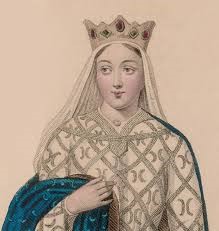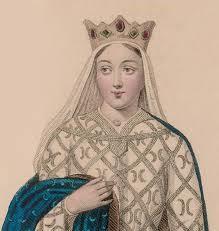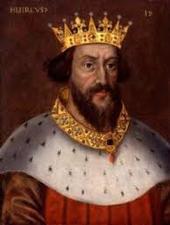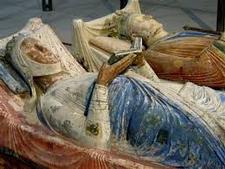Eleanor of Aquitaine was one of the most powerful women in medieval Europe. She was Queen of France and England, held influence over some of the most powerful Kings of the day, marched with a crusading army to the Holy Land and was mother to one of the most celebrated monarchs in English history. Shrewd, ambitious and ferociously clever, she used her position as the most desirable bride in Europe to elevate herself to power, power she would fight unrelentingly to protect.
In a world dominated by violent men, Eleanor used her beauty and femininity to charm and control the most formidable of them and wielded extraordinary power as a result. Yet she was unafraid to engage in the ‘male’ pursuit of war, leading rebellions when it suited her. By the time she died, at the unusually old age of 82, she could count several European rulers among her extended family and therefore was arguably the first ‘grandmother of Europe’, 700 years before Queen Victoria would receive that nickname.
Early Life
The exact date of Eleanor’s birth is unknown, but it is most likely to have been some time in the year 1122. She was the daughter of Duke William X of Aquitaine, a region in what is now southern France. In fact, Aquitaine was so large that the Duke controlled more lands than even the King of France, making him one of the most powerful men in western Europe.
Aside from the death of her brother when she was five, Eleanor had a happy childhood, with William showering his daughter with affection and ensuring that she received an elite education. Gabby Storey explains that William was keen on philosophy and literature and presided over a fantastically cultured court, meaning that Eleanor was afforded the opportunity to talk with and learn from some of the brightest minds of the day. She was also an avid horse rider.
Queen of France
Eleanor’s serene world came crashing down when her father died in 1137. At the age of 15, she was now the Duchess of Aquitaine and by far the most eligible young woman in the whole of Europe. William had asked for his overlord, the King of France, to provide guardianship for his daughter until she came of age to take control of the region, but the King had a better idea than that. He promptly married her to his son Louis and took control of Aquitaine for himself, but then equally as promptly found himself lying on his own deathbed. Louis ascended to the throne and by the end of the year, Eleanor had become Queen of France.
Eleanor as a young woman
Although Louis adored his bride, whose beauty and wit was known throughout Europe, the marriage would not be a happy one. For a start, it only produced two daughters, meaning that Eleanor had failed in the first duty of any medieval Queen – to provide a male heir. Secondly, Eleanor’s influence over the King did not produce healthy outcomes for the kingdom, as shown in 1141 when she persuaded him to allow the Count of Vermandois to marry her younger sister, Petronilla. The idea was brilliant as far as Eleanor’s family were concerned, but there was just one problem; the Count was already married, to a relation of Count Theobald of Champagne. The episode caused friction between the new King and the powerful Count Theobald, and Eleanor’s reputation was further damaged when her sister and the Count of Vermandois were excommunicated from the church for their bigamous marriage.
The immature King Louis proceeded to invade Champagne and ordered the burning down of church in the town of Vitry, not realising that it was full of women and children who had sought refuge. The episode caused outrage in France and Eleanor was tainted by association.
Louis was tormented with guilt for his role in the massacre at Vitry and saw an opportunity for redemption when the Pope called for a crusade in 1145. Eleanor joined him for the journey to the Hold Land, but it was ill-fated. Already strained by the previous few years, their marriage deteriorated further when their armies were routed by the Turks and when Eleanor sided with her uncle, Raymond, during an argument between him and the King about strategy. The estranged couple returned to France via Rome in 1149 and, despite a brief reconciliation, Eleanor was granted an annulment by the Pope in 1152 on the tenuous grounds that she and Louis were too closely related. Her daughters would remain in the custody of their father.
Eleanor's second husband, Henry of Anjou, became Henry II of England in 1154.
Now single again and in sole control of Aquitaine, Eleanor started to think about her own lineage. She too was keen to have a son who could provide stability to her dynasty in Aquitaine, but she would not just marry any man. Fending off the attentions of almost every bachelor on the continent, she married Henry, the Duke of Anjou and bitter rival of her ex-husband, only eight weeks after her previous marriage was annulled. Henry was thrilled with his coup as it meant he could secure Aquitaine and possibly produce heirs for the region who would make the claims of King Louis and his daughters redundant. Eleanor was pleased to be married to a young, handsome and – most crucially – ambitious ruler. Henry had plans to take the throne of England for himself because his mother, the Empress Matilda, had been the rightful heir to the English throne before King Stephen usurped her.
Henry braved harsh winter storms to arrive in England unexpectedly in early 1153 and began a brutal conquest of the land until the King Stephen was forced to named him as his heir. Stephen died in October 1154 and Henry of Anjou became Henry II of England. Eleanor of Aquitaine was now Queen of England.
Though impetuous and prone to violence, Henry’s energy made him an effective King. He is credited with establishing the basis of what is now known as English common law and stamped his authority on an unruly noble class who had begun to illegally construct their own castles under King Stephen. Eleanor had a crucial role in all of this. While she could not control Henry as she had Louis, he entrusted her with the whole kingdom of England for large parts of his early reign as he tried to deal with his sizeable lands on the continent. The son of another immensely powerful woman, Henry valued Eleanor’s presence and the marriage had all the chemistry that had been lacking in Eleanor’s previous marriage. Indeed, the match produced eight children: five sons and three daughters (although the eldest son, William, died in infancy).
The Court of Love at Poitiers
However, two strong characters such as Henry and Eleanor could not get along for too long. When Henry returned to England for good the couple found themselves in regular conflict and Eleanor separated from her husband to live in Poitiers, in the west of France, in 1168. Her move was well-timed – only two years later an increasingly erratic Henry was implicated in the brutal murder of Thomas Beckett, the Archbishop of Canterbury. It was during her five-year spell presiding over Poitiers that the legend of the Court of Love was established. Eleanor, always a flirtatious character, is said to have established the chivalric code among her courtiers which was to have a considerable influence over poetry and literature for years to come.
Rebellion and imprisonment
By the 1170s, Henry’s domineering presence over his family had caused an irreparable rift. He had allowed his eldest surviving son, also named Henry, to become a ruler-in-waiting and had given lands on the continent to his other sons, but they resented their father’s authoritarian control over their affairs. Similarly, Eleanor was unhappy with Henry’s attempts to exert more control over her lands in Poitiers and Aquitaine and his side-lining of her in major state matters. The ‘Young King’ Henry fled to France to organise a rebellion with his brother, Richard, and Eleanor was at the centre of it all. In April of 1173 the brothers launched their invasion of England with help from France and Scotland, but amazingly King Henry managed to cling on to power and defeat all his enemies within a year. Eleanor tried to find refuge with her first husband, still King of France, but was arrested before she could reach safety and placed under house arrest for her treason. She would remain there for 15 years.
During her imprisonment, she had to deal with the heartbreak of losing two of her sons: Henry to disease in 1183 and Geoffrey to a jousting accident in 1186. Undeterred, she kept plotting against her husband and is even said to have had a role in the death of his favourite mistress, Rosamund. In his later years, King Henry started to relent and Eleanor could be seen by his side at formal state gatherings, but her imprisonment would not end until his death in 1189. One of the first actions of his successor, Richard, was to release his mother from imprisonment. Eleanor was free again and had the ear of yet another powerful monarch.
Later Years
King Richard I would go on to be nicknamed ‘the Lionheart’ for his valiant conduct while crusading in the Holy land but neglected his own kingdom, leaving room for the youngest brother, John, to try and take the throne for himself. The episode has since been immortalised by the Robin Hood legend, but rather than the good people of Nottingham resisting John’s advances it was Eleanor who discouraged her youngest son from his attempts to take the throne.
Richard died heirless in 1199, leaving John to be crowned legitimately. He still saw value in his formidable mother, who despite being nearly 80 was despatched to France as his envoy. By this time Eleanor’s daughters had all married prominent rulers across Europe, giving her politically valuable grandchildren. Still physically active and having not lost her keen political mind, in 1200 she made the journey across the Pyrenees to collect her granddaughter from Castile in Spain so that she could marry the heir to the French throne. In the same year, she resisted attempts by her grandson, Arthur of Brittany, to take control of Anjou and Aquitaine, thus preserving those lands for King John.
Eleanor finally retired in around 1202 and lived the rest of her life at the monastery in Fontevrault, Anjou. She died here on 1st April 1204 and was buried there next to her husband Henry. In death then, the couple achieved something they never had in life – they would lie together in silence.
Eleanor’s was not a rags-to-riches story. She was born into immense privilege and never fell out of Europe’s elite ruling class. But hers was still an extraordinary story. Far from accepting her place as the unhappy wife of the French King, she used her eligibility, charm and intelligence to secure another Kingdom for herself and would leave an irreplaceable mark there. Even in her second marriage, she did not meekly accept her husband’s transgressions and challenged him to within inches of losing his throne. Given the era she found herself operating in, her life was unfortunately defined by her relationships with the men around her. However, she was usually the dominant partner in these relationships and dictated their dynamics. By the time of her death she had family in several European royal courts and her influence was unmatched by any woman in her lifetime. She thoroughly earned her place as one of history’s most formidable women.
Eleanor and Henry's joint tomb in the monastery in Fontevrault.
Acknowledgements
The Ministry of History is not an academic source. Our pieces are written by writers who have been studying history for years and are well versed in and influenced by countless other writers and works. For this article specifically our sources have included:
'Eleanor of Aquitaine', article published by bbc.co.uk
'Eleanor of Aquitaine', episode in the You're Dead to Me podcast series, hosted by Greg Jenner and featuring Gabby Storey, published by BBC sounds (2020)
'Eleanor of Aquitaine's children and grandchildren', article by Jone Johnson Lewis, published by thoughtco.com (2017)
'Eleanor of Aquitaine: The Medieval Queen who took on Europe's most powerful men', article by Lindy Grant, published by historyextra.com (2020)
Images
Image one - britishheritage.com
Image two - treesofblue.com
Image three - thedrinksbusiness.com



